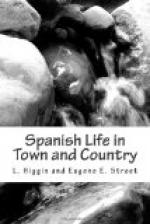Although they lie so close together, Asturias differs widely from its sister province both in the character of its people and its scenery. The Romans took two hundred years to subdue it, and the Moors never obtained a footing there. The Asturians are a hardy, independent race, proud of giving the title to the heir-apparent of the Spanish throne. The people of this province, like their neighbours the Basques, are handsome and robust in appearance; they are always to be recognised in Madrid by their fresh appearance and excellent physique. For the most part they are to be found engaged in the fish trade, while their women, gorgeously dressed in their native costume by their employers, are the nurses of the upper classes.
[Illustration: VALENCIANOS]
The ladies of Madrid do not think it “good style” to bring up their own children, and the Asturian wet nurse is as much a part of the ordinary household as the coachman or mayordomo. They are singularly handsome, well-grown women, and become great favourites in the houses of their employers; but, like their menkind, they go back to spend their savings among their beloved hills. Many of these young women come to Madrid on the chance of finding situations, leaving their own babies behind to be fed by hand, or Heaven knows how; they bring with them a young puppy to act as substitute until the nurse-child is found, and may be seen in the registry offices waiting to be hired, with their little canine foster-children. It is said that the Asturian women never part from the puppies that they have fed from their own breasts.
The Basque Provinces are, perhaps, the best known to English travellers, since they generally enter Spain by that route, and those staying in the south of France are fond of running across to have at least a look at Spain, and to be able to say they have been there. The people pride themselves on being “the oldest race in Europe,” and are, no doubt, the direct descendants of the original and unconquered inhabitants of the Iberian Peninsula. In Guipuzcoa, the Basque may still be seen living in his flat-roofed stone house, of which he is sure to be proprietor, using a mattock in place of plough, and leading his oxen—for bueyes are never driven—attached to one of the heavy, solid-wheeled carts by an elaborately carved yoke, covered with a sheepskin. He clings tenaciously to his unintelligible language, and is quite certain that he is superior to the whole human race.




